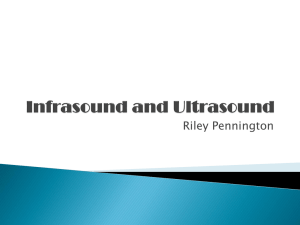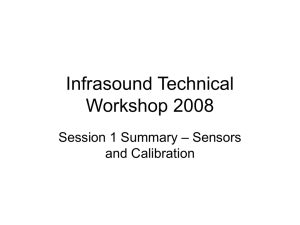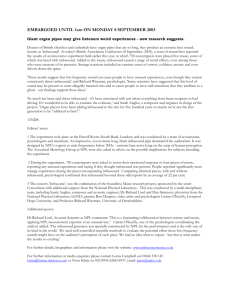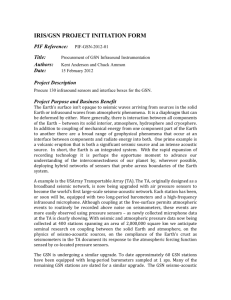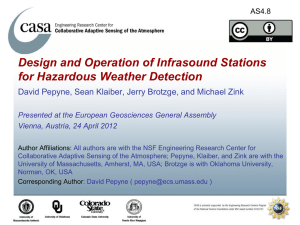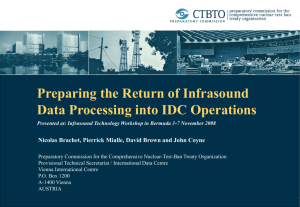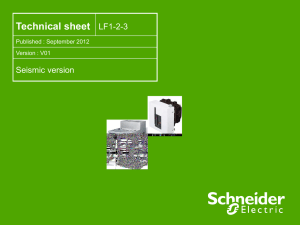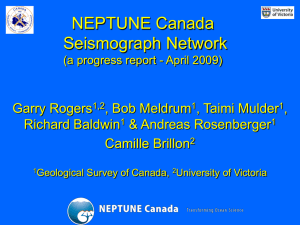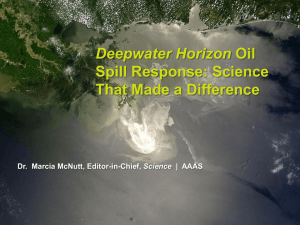Presentation - Copernicus.org
advertisement
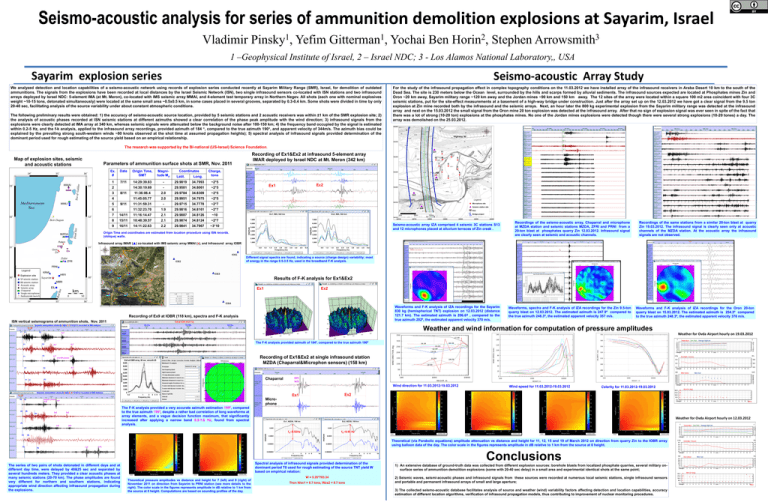
Seismo-acoustic analysis for series of ammunition demolition explosions at Sayarim, Israel Vladimir 1 Pinsky , Yefim 1 Gitterman , Yochai Ben 2 Horin , 3 Stephen Arrowsmith 1 –Geophysical Institute of Israel, 2 – Israel NDC; 3 - Los Alamos National Laboratory,, USA Sayarim explosion series Seismo-acoustic Array Study We analyzed detection and location capabilities of a seismo-acoustic network using records of explosion series conducted recently at Sayarim Military Range (SMR), Israel, for demolition of outdated ammunitions. The signals from the explosions have been recorded at local distances by the Israel Seismic Network (ISN), two single infrasound sensors co-located with ISN stations and two infrasound arrays deployed by Israel NDC: 5-element IMA (at Mt. Meron), co-located with IMS seismic array MMAI, and 4-element test temporary array in Northern Negev. All shots (each one with nominal explosives weight ~10-15 tons, detonated simultaneously) were located at the same small area ~0.5x0.5 km, in some cases placed in several grooves, separated by 0.3-0.4 km. Some shots were divided in time by only 20-40 sec, facilitating analysis of the source variability under about constant atmospheric conditions. The following preliminary results were obtained: 1) the accuracy of seismo-acoustic source location, provided by 5 seismic stations and 2 acoustic receivers was within ±1 km of the SMR explosion site; 2) the analysis of acoustic phases recorded at ISN seismic stations at different azimuths showed a clear correlation of the phase peak amplitude with the wind direction; 3) infrasound signals from the explosions were clearly detected at IMA array at 340 km, whereas seismic signals were attenuated below the background noise after 100-150 km; 4) the frequency band occupied by the signal is estimated within 0.2-5 Hz, and the f-k analysis, applied to the infrasound array recordings, provided azimuth of 184 , compared to the true azimuth 190, and apparent velocity of 344m/s. The azimuth bias could be explained by the prevailing strong south-western winds ~80 knots observed at the shot time at assumed propagation heights); 5) spectral analysis of infrasound signals provided determination of the dominant period used for rough estimating of the source yield based on an empirical relationship. For the study of the infrasound propagation effect in complex topography conditions on the 11.03.2012 we have installed array of the infrasound receivers in Araba Desert 10 km to the south of the Dead Sea. The site is 230 meters below the Ocean level, surrounded by the hills and scarps formed by alluvial sediments. The infrasound sources expected are located at Phosphates mines Zin and Oron ~20 km away, Sayarim military range ~120 km away and the Jordan mines ~90 km and 150 km away. The 12 sites of the array were located within a square 100 m2 area coincident with four 3C seismic stations, put for the site-effect measurements at a basement of a high-way bridge under construction. Just after the array set up on the 12.03.2012 we have got a clear signal from the 9.5 ton explosion at Zin mine recorded both by the infrasound and the seismic arrays. Next, an hour later the 800 kg experimental explosion from the Sayarim military range was detected at the infrasound array and next on the 15.03.2012 the small signal from the Oron mine 20 ton explosion was detected at the infrasound array. After that no sign of explosion signal was ever seen in spite of the fact that there was a lot of strong (10-20 ton) explosions at the phosphates mines. No one of the Jordan mines explosions were detected though there were several strong explosions (10-20 tones) a day. The array was demolished on the 25.03.2012. The research was supported by the Bi-national (US-Israel) Science Foundation. Map of explosion sites, seismic and acoustic stations Recording of Ex1&Ex2 at infrasound 5-element array IMAR deployed by Israel NDC at Mt. Meron (342 km) Parameters of ammunition surface shots at SMR, Nov. 2011 Ex. # Date 1 7/11 2 3 8/11 4 5 9/11 6 Coordinates Origin Time, GMT Magnitude Md Latit. Long. Charge, tons 14:29:39.83 - 29.9819 34.7993 ~2*5 14:30:19.69 - 29.9581 34.8061 ~2*5 11:36:06.4 2.0 29.9784 34.8309 ~2*5 11:45:05.77 2.0 29.9951 34.7975 ~2*5 11:31:59.31 - 29.9715 34.7778 ~2*7 11:32:23.70 1.9 29.9816 34.8161 ~2*7 7 14/11 11:16:14.47 2.1 29.9887 34.8126 ~10 8 15/11 10:48:39.57 2.1 29.9874 34.8124 ~2*7 9 16/11 14:11:22.63 2.2 29.9841 34.7967 Ex2 Ex1 Seismo-acoustic array IZA comprised 4 seismic 3C stations S13 and 12 microphones placed at alluvium terraces of Zin creak . ~3*10 Origin Time and coordinates are estimated from location procedure using ISN records. (oblique) walls. Recordings of the seismo-acoustic array, Chaparral and microphone at MZDA station and seismic stations MZDA, ZFRI and PRNI from a 20-ton blast at phosphates quarry Zin 12.03.2012. Infrasound signal are clearly seen at seismic and acoustic channels. Recordings of the same stations from a similar 20-ton blast at quarry Zin 19.03.2012. The infrasound signal is clearly seen only at acoustic channels of the MZDA station. At the acoustic array the infrasound signals are not observed. Infrasound array IMAR () co-located with IMS seismic array MMAI (), and Infrasound array IOBR Different signal spectra are found, indicating a source (charge design) variability; most of energy in the range 0.5-3.5 Hz, used in the broadband F-K analysis. Results of F-K analysis for Ex1&Ex2 Ex1 Ex2 Waveforms and F-K analysis of IZA recordings for the Sayarim 830 kg (hemispherical TNT) explosion on 12.03.2012 (distance 121.7 km). The estimated azimuth is 206.6º , compared to the true azimuth 202º, the estimated apparent velocity 370 m/s. Recording of Ex9 at IOBR (118 km), spectra and F-K analysis ISN vertical seismograms of ammunition shots, Nov. 2011 Waveforms, spectra and F-K analysis of IZA recordings for the Zin 9.5-ton quarry blast on 12.03.2012. The estimated azimuth is 247.9º compared to the true azimuth 248.3º, the estimated apparent velocity 357 m/s. Waveforms and F-K analysis of IZA recordings for the Oron 20-ton quarry blast on 15.03.2012. The estimated azimuth is 254.3º compared to the true azimuth 248.3º, the estimated apparent velocity 376 m/s. Weather and wind information for computation of pressure amplitudes Weather for Ovda Airport hourly on 19.03.2012 The F-K analysis provided azimuth of 184º, compared to the true azimuth 190º Recording of Ex1&Ex2 at single infrasound station MZDA (Chaparral&Microphon sensors) (158 km) Chaparral 275 m/s Wind direction for 11.03.2012-19.03.2012 Wind speed for 11.03.2012-19.03.2012 Celerity for 11.03.2012-19.03.2012 Ex2 Ex1 Microphone The F-K analysis provided a very accurate azimuth estimation 195º, compared to the true azimuth 196º, despite a rather bad correlation of long waveforms at array elements, and a vague decision function maximum, that significantly increased after applying a narrow band 0.8-1.8 Hz, found from spectral analysis. Weather for Ovda Airport hourly on 12.03.2012 fm~0.93Hz fm~0.86 Hz Theoretical (via Parabolic equations) amplitude attenuation vs distance and height for 11, 12, 15 and 19 of March 2012 on direction from quarry Zin to the IOBR array using balloon data of the day. The color scale in the figures represents amplitude in dB relative to 1 km from the source at 0 height. The series of two pairs of shots detonated in different days and at different day time, were delayed by 40&25 sec and separated by several hundreds meters. They provided a clear acoustic phases at many seismic stations (20-70 km). The phase amplitudes are found very different for northern and southern stations, indicating appropriate wind direction affecting infrasound propagation during the explosions. Spectral analysis of infrasound signals provided determination of the dominant period T0 used for rough estimating of the source TNT yield W based on empirical relation: W = 5.26*T03.34 Theoretical pressure amplitudes vs distance and height for 7 (left) and 9 (right) of November 2011 on direction from Sayarim to PRNI station (see more details to the right). The color scale in the figures represents amplitude in dB relative to 1 km from the source at 0 height. Computations are based on sounding profiles of the day. Then Wex1 = 6.7 tons, Wex2 = 8.7 tons Conclusions 1) An extensive database of ground-truth data was collected from different explosion sources: borehole blasts from localized phosphate quarries, several military onsurface series of ammunition demolition explosions (some with 20-40 sec delay) in a small area and experimental identical shots at the same point; 2) Seismic waves, seismi-acoustic phases and infrasound signals from these sources were recorded at numerous local seismic stations, single infrasound sensors and portable and permanent infrasound arrays of small and large aperture; 3) The collected seismo-acoustic database facilitates analysis of source and weather (wind) variability factors affecting detection and location capabilities, accuracy estimation of different location algorithms, verification of infrasound propagation models, thus contributing to improvement of nuclear monitoring procedures.
